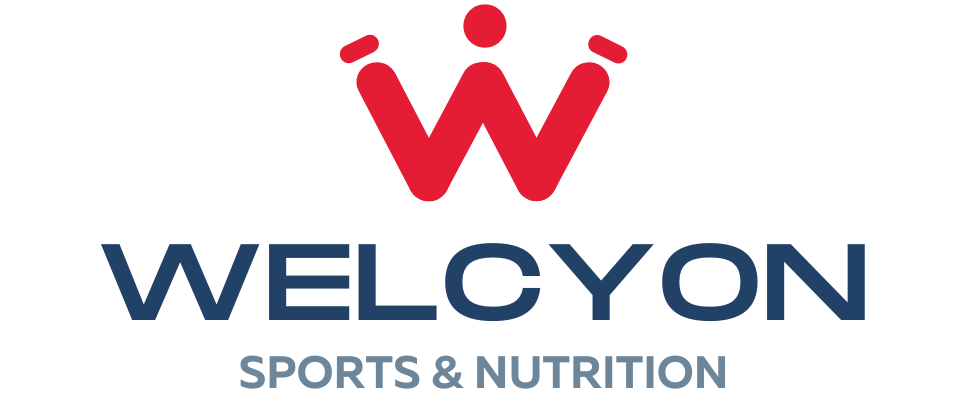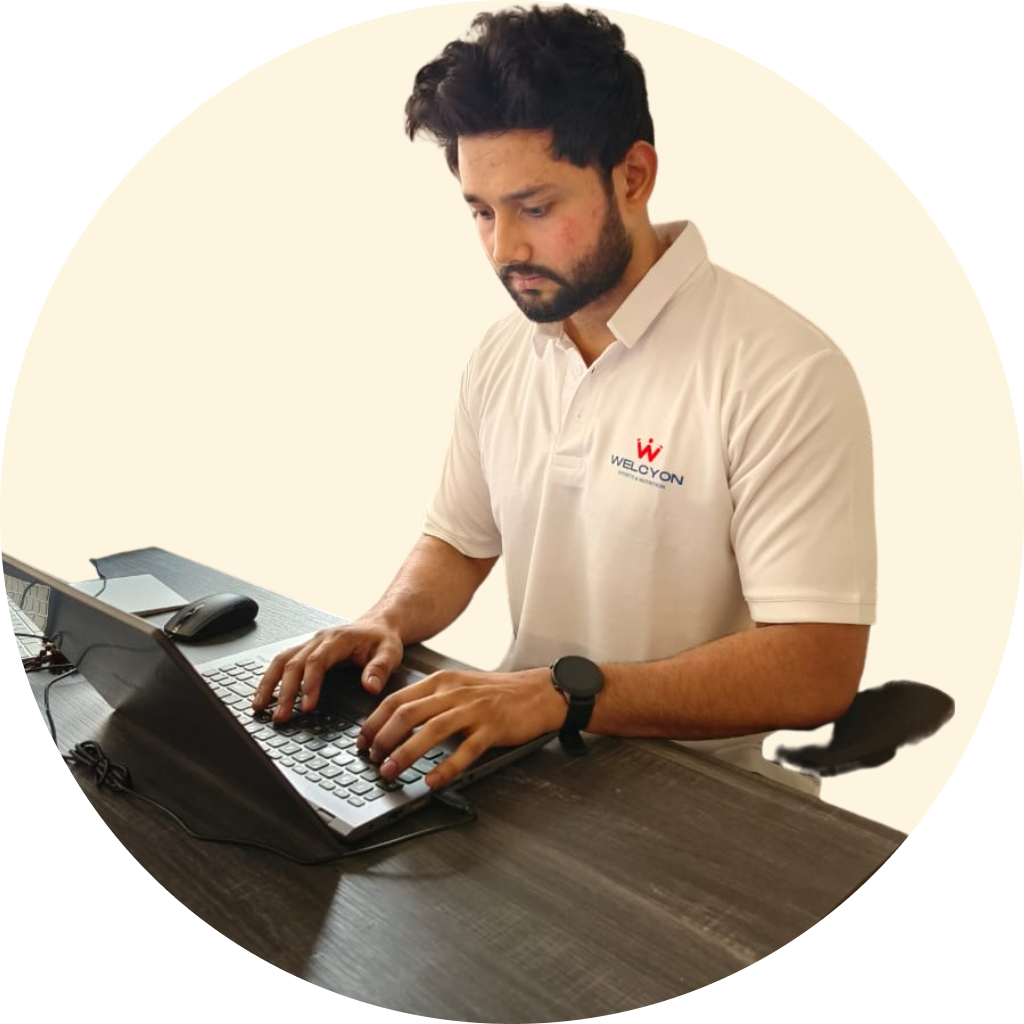Several leg exercises specifically target different types of muscles. Exercises targeting the lower back, glutes, thigh, and calf muscles are the most recommended to build toned legs.
One of those exercises is the barbell back squats, a favorite among fitness enthusiasts. However, this exercise strains the leg and back muscles pretty easily. Hence, people started to lean more towards the goblet squats.
The goblet squats is an easy-to-do exercise that puts less pressure on your legs and back and builds strong and muscular legs. It is a highly versatile exercise, which means that it can be performed using any equipment available, and you can add variations as well.
So to learn about the goblet squats and their variations, keep reading this article!
What Are Goblet Squats?
The goblet squat is an alternative to barbell squats and is one of the most famous lower body exercises. In this exercise, you perform a regular squat movement with the addition of holding a weight in your hands. The weight is usually held closer to the chest with your elbows almost touching the sides of your body.
This exercise can be performed using any weight, such as a weight plate or a dumbbell, but most commonly, a kettlebell is used.
This exercise requires the weight to be held in the front, allowing your back to remain much more stable and upright. This additional support does not strain your back muscles.
Muscles Targeted By Goblet Squats
Goblet squats are perfect for targeting almost all the muscles of the thighs and legs. Muscles worked during elevated goblet squat are,
- Gluteus maximus
- The quadriceps
- Hamstrings
- Hip flexors
- Calves muscles
As the back is in its most upright position by holding the weight in front, this exercise takes off the stress from the back muscles. Instead, it mainly targets the quadriceps and shifts the weight towards the hamstring and the glutes. Furthermore, the spinal erectors' muscles work to assist in lifting the heavy loads and maintain proper form during goblet heel elevated squats and other exercises.
The quadriceps, located in the anterior part of the thigh, are the hip flexors and the knee extensors of the body. They are composed of four muscles: the rectus femoris, the vastus lateralis, the vastus intermedius, and the vastus medialis. (1)
The vastus medialis and the rectus femoris muscles are very strong and give the thigh that bulky muscle mass.
Advantages Of The Goblet Squats
There are several benefits of performing goblet heel elevated squats. The best advantage is that it is excellent for leg day and helps with strength training, and your back muscles do not get strained. This is because the weight evenly distributed is now at your upright torso instead of the back.
Secondly, goblet heels elevated squats are pretty easy to perform as there are no specifications. They are a great lower body exercise that can be performed with equipment like dumbbells, barbells, weight plates, etc.
Goblet squats also do not require a lot of space; hence they are a favorite to fitness enthusiasts on the go or when they can not visit the gym.
Moreover, goblet squats have several variations, each targeting specific muscles or most leg muscles while improving the range of motion. This way, goblet squats and their variations make for an excellent leg workout that promotes muscle growth. (2)
Limitations Of The Goblet Squats
The reason why people have invented variations is due to some limitations of the goblet squats. Significant restrictions of goblet squats are that some people can not hold too much weight in the front of their chest and have poor hip conditions. This results in a less weight tolerance ratio than the traditional squats, traditional back squat, or barbell squats.
Moreover, goblet squats only target specific muscles, leaving out important ones like the quadriceps. Hence performing goblet squats with variation is recommended.
How To Perform A Goblet Squat Properly?
Before jumping into variations, let us first learn the proper way of doing the goblet squats. If you do not perform the goblet squat form correctly, performing the variations will become problematic.
Here is a complete guide on the goblet squats. (3)
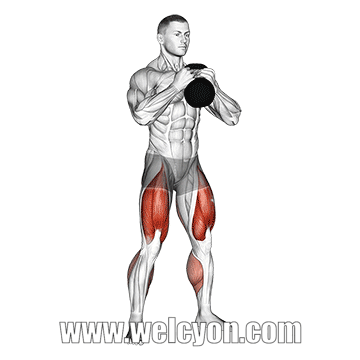
Equipment Needed
- Any weight or none
Muscles Targeted
- Quadriceps
- Glutes
- Hips
- Calves
- Hamstrings.
Instructions
- Select any weight of the choice, such as dumbbells, barbells, weight plates, or kettlebells.
- Stand up straight, making sure that your feet are shoulder-width apart.
- Hold the weight with both hands, positioning it in front of your upper body so that your elbows are below your hands. Make sure that your palms are facing inwards.
- Now perform the squat by lowering your hips and bending your knees till your elbows touch the thighs, thighs are parallel with the floor, or knees are directly above your toes. At this point, squeeze your glutes and quadriceps.
- Now come back to your original position from the bottom position, and continue until the rep is complete.
- You can also watch this instructional video to hack squats.
Training Tips
- Maintaining an upright posture is always recommended, but the spine should be neutral, so you do not get back pain.
- Always keep the elbows close to the body and look straight forward to avoid straining the neck.
7 Variations Of The Goblet Squats
Here are the seven variations of the goblet squats with step-by-step instructions that you can efficiently perform at home or the gym using minimum equipment.
1. How To Sumo Goblet Squats
The traditional goblet squat distributes the load over the leg muscles and the lower back. However, the sumo squat works the muscles of the inner thighs and the groin area. This results in much more muscular thighs and improved lifting power. (4)
The difference between the goblet squat and the sumo squat is that this variation requires you to open your legs wide apart rather than hip-width.
Equipment Required
- Dumbbell
- Kettlebell
- Weight plate
Muscles Targeted
- Quadriceps
- Glutes
- Inner thighs
- Hips
- Calves
- Hamstrings.
Instructions
- Stand with your back straight and open your feet as wide as it is comfortable (4 feet) or at least wider than shoulder-width apart. Make sure that your toes are pointing forwards.
- Hold the weight with both your hands in the front of your chest.
- Angle your toes at about 45 degrees away from the body's center.
- Gradually, bend your knees and lower your hips backward to perform the squat such that your knees are directly above your toes. You must perform the sumo squat while keeping your back straight and your head facing forward.
- It is recommended to perform the squat until your thighs are completely parallel with the floor. You can go as low as you can. Pause for a few seconds and squeeze your glutes and thigh muscles.
- Return to that position and perform this sumo squat until the rep is complete.
- You may complete 8 to 10 reps of this exercise.
Training tips
- Make sure that you can keep your back straight while holding the weight. Posture is key.
- Do not lift your heels while performing a sumo squat.
- For beginners, it is better to gradually increase the distance between your feet rather than starting directly from 4 feet.
- For beginners, it is also recommended to start with light weights.
2. How To Heels Elevated Goblet Squat
The heels elevated squats are one of the best variations of the goblet squat because it completely isolates the quadriceps. It also keeps the core engaged, targets the hamstrings, and improves ankle mobility. (5)
The heels elevated goblet squat requires your heels to be elevated rather than straight on the floor. The elevation helps keep your back straighter and shift the weight forward so that the hips and thighs are more actively taking the pressure. Heels elevated goblet squat is ideal for beginners and pros.
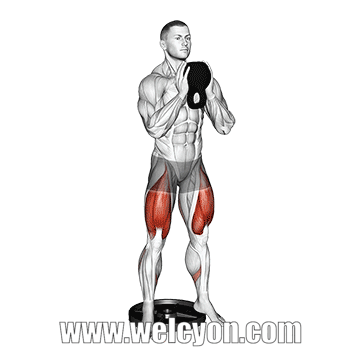
Equipment Required
- Dumbbell
- Kettlebell
- Weight plates
Muscles Targeted
- Quadriceps
- Glutes
- Abductors
- Adductors
- Core
- Hamstrings.
Instructions
- Keep two weight plates on the floor with a shoulder-width distance between them. You can use anything to elevate your heels if weight plates are not available.
- Stand on the weight plates, but ensure that your toes touch the ground.
- Now hold the weight with an inward grip using both of your hands. It does not matter how much weight you take for this exercise; it is your choice.
- Bend your knees and squat by lowering your hips until your thighs parallel the ground. Squeeze your glutes at this point.
- Get back to the starting position while maintaining the tension in your knee joints. Repeat heels elevated squat as many times as you want.
Training Tip
- Keep your lumbar spine neutral throughout the heels elevated squat.
3. How To Goblet Split Squat
The Goblet split squat is another goblet squat variation on our list that primarily targets the quadriceps in the lower body. In this exercise, one leg balances and stabilizes the body while the other leg's muscles are worked upon, building strength and muscle mass.
This exercise is usually performed using dumbbells and is one of the best exercises for isolating the quadriceps completely.
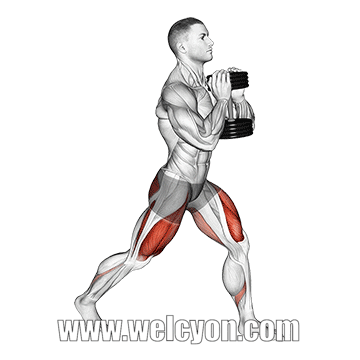
Equipment Needed
- Dumbbells
Muscles Targeted
- Quadriceps
- Upper back
- Hamstrings
Instructions
- Pick up dumbbells in both the hands with an inward grip. Position your hands at chest height by bending your elbows.
- Next, get in a split stance position by putting one foot forward and one backward. Keep your hands on your sides.
- Lower your body to perform the squat by bending your knees till the back foot almost touches the ground and the forward knee is directly above the front foot.
- Return to the starting position using the front foot only.
- Repeat this movement with the other leg on the front and complete the desired number of repetitions.
Training Tips
- It is better to keep your lumbar spine neutral rather than upright.
- If you want to put more pressure on your hamstrings and quadriceps, lean forward.
4. How To Kettlebell Goblet Squat
This compound exercise is an easier one, and it is the best for beginners as well. The kettlebell goblet squat targets the quadriceps especially.
When the kettlebell is held close to the chest with an inward grip, it uniformly distributes the pressure and helps isolate the leg muscles much more easily. (6)
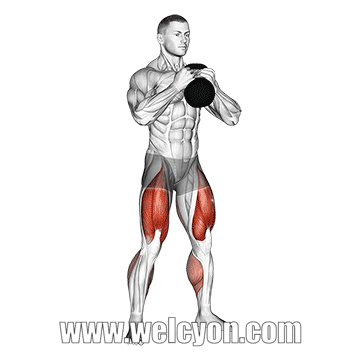
Equipment Needed
- Kettlebell
Muscles Targeted
- Quadriceps
- Glutes
- Core muscles
Instructions
- Stand straight with your torso upright and feet shoulder-width apart.
- Hold a kettlebell with both hands and position it in front of your chest.
- Next, start squatting by bending your knees and lowering your hips till your thighs are parallel with the ground or knees are directly above the toes.
- Return to the starting position and repeat as many times as you want.
- Begin with 3 sets of 10 reps of this workout.
Training Tips
- It is recommended for beginners to start with lighter weights and then gradually increase. However, the weight should be challenging.
- Keep the elbows closer to the body.
- Try to hold the squat position for 10 seconds for maximum effect.
5. How To Goblet Squat With Plate
This variation is for those of you who only have weight plates available. The goblet squat with a plate is another great exercise to get your leg muscles worked on.
This exercise targets the quadriceps by isolating them, resulting in strong and built legs and improved ankle mobility.
Equipment Needed
- Weighted plate
Muscles Targeted
- Quadriceps
- Leg muscles
Instructions
- Open your feet slightly wider than shoulder-width apart and hold a weight plate in your hands like a steering wheel. This is your starting position.
- Next, keep your back straight in a more upright position and squat by bending the knees and lowering the back.
- Continue squatting until the knees are directly above your toes.
- Return to the starting position by pushing your feet and perform the same movement until reps are complete.
Training Tips
- Make sure you lower your body until your thighs parallel the ground.
- Keep your lumbar spine neutral to achieve proper alignment.
- Do not cave in the shoulders due to the weight.
6. How To Landmine Goblet Squats
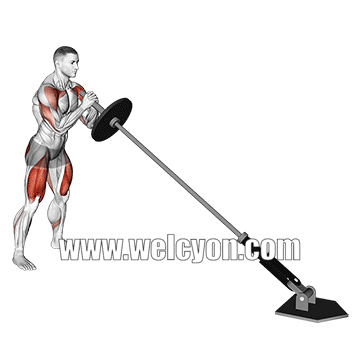
The landmine goblet squat is another excellent variation that uses a piece of equipment called 'the landmine.' This equipment can revolve 360 degrees and is mounted on a fixed stand.
Apart from working on the leg muscles, this exercise is also great for the knees and muscle building. It reduces knee pain and helps in improving knee injuries as well. (7) This exercise requires a bit of technique and lifting strength; hence beginners might need to practice at the start.
Equipment Needed
- Landmine
- Weight plates
Muscles Targeted
- Quadriceps
- Glutes
- Hamstrings
- Triceps
- Abs
- Deltoids
- Trapezius muscles
Instructions
- Stand with your feet shoulder-width apart. Now, squat down using the same technique of bending the knees and lowering the back until the thighs are parallel with the ground.
- Next, hold the landmine with both hands and stand using your upper body. At this point, your body will be in an inclined position.
- Now, squat and repeat this movement to complete reps of the landmine goblet squat.
Training Tips
- Keep your body inclined while standing up.
- Add however many weight plates you want. We recommend starting with lighter weights.
7. How To Banded Goblet Squat
The last variation of the goblet squat on our list is the banded goblet squat. As the name explains, this version of goblet squats involves a band. It gives you the resistance to isolate the muscles entirely and build muscle. (8)
It is a great exercise to perform while traveling when you cannot carry around heavy weights like dumbbells, kettlebells, or barbells.
Equipment Needed
- Band
Muscles Targeted
- Quadriceps
- Glutes
- Hamstrings
Instructions
- Stand with space between your feet straight below the outside of your shoulders.
- Place the resistance band under your feet, and then pull the part of the band on the ground using both hands. The band will form a triangular shape.
- While holding the band close to your chest, start squatting by lowering your hips until the thighs parallel the floor.
- You can also stop when your knees come directly above your toes.
- Return to the starting position and repeat until the reps are complete.
Training Tips
- Hold the band with an inward grip.
- Keep your elbows close to the body.
- Try to keep your back straight and spine neutral.
Wrapping Up
In conclusion, goblet squats are perfect if you want to build your dream bulky and strong legs! They are a great lower body workout that targets the leg muscles specifically.
While the goblet squat focuses more on the quadriceps, its variations also target other muscle groups. This includes the core muscles, the hamstrings, the calves, and the gluteus maximus.
The equipment and weights in these variations provide additional resistance and pressure for building muscle and isolation.
All the variations we discussed above are the best for targeting the leg muscles, especially the thigh muscles or the quadriceps.
Ensure you follow all the instructional steps and training tips to avoid muscle strain and achieve an effective leg day.
We hope that this article will prove to be helpful and will help you in achieving all your fitness goals very soon. Good luck!
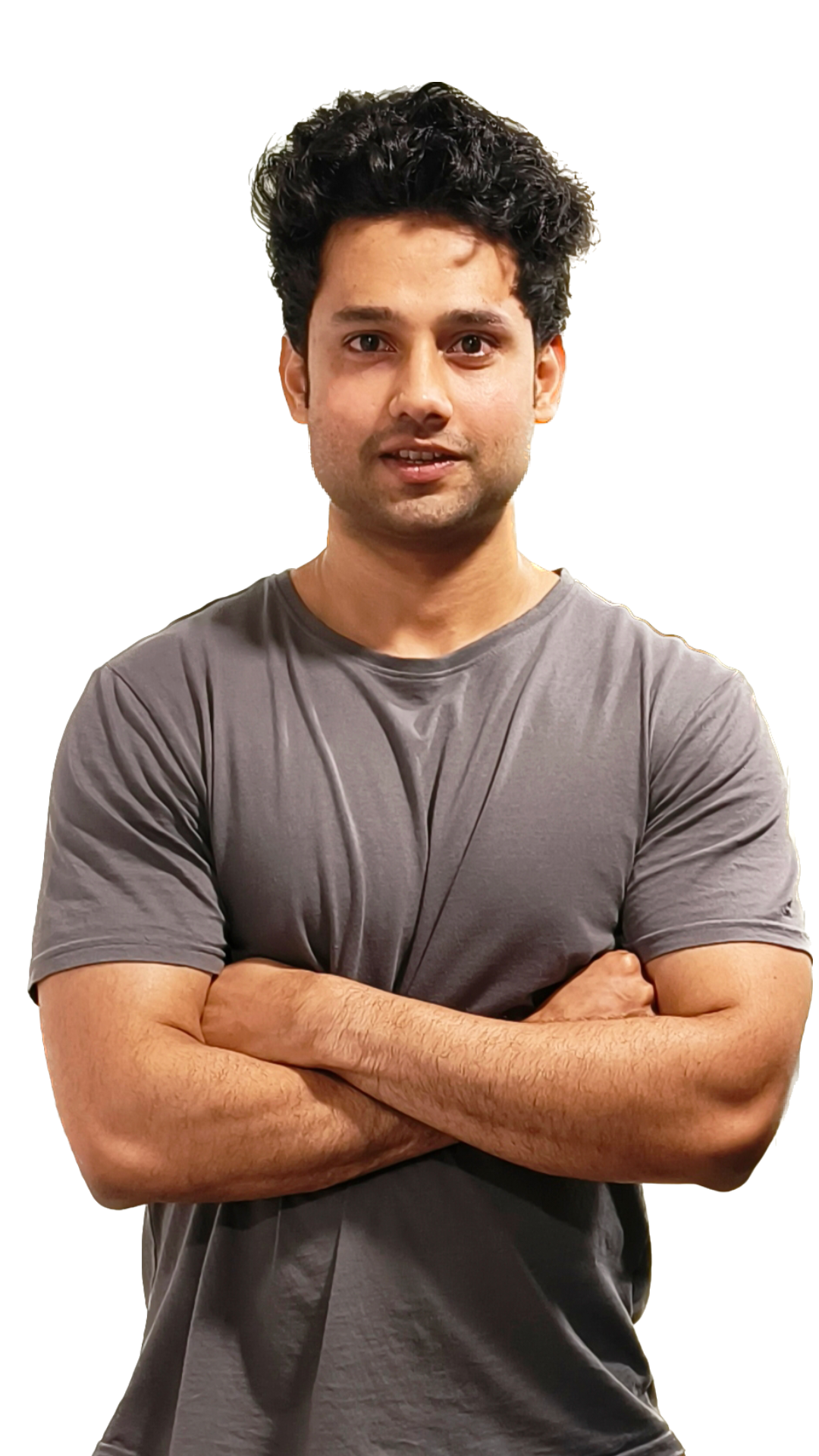
Aditya Sahu ‧ CPT & Head Coach
Aditya is an ACSM certified personal trainer with more than 7 years training various people and transforming people's lives. He has written various publications for various sports and fitness magazines.
Sources
- https://www.medicalnewstoday.com/articles/quadriceps-muscles#:~:text=The%20quadriceps%20are%20a%20group,such%20as%20walking%20and%20jumping.
- https://www.medicinenet.com/what_does_a_goblet_squat_work/article.htm#:~:text=of%20goblet%20squats%3F-,The%20goblet%20squat%20works%20all%20the%20major%20muscle%20groups%20of,the%20shoulders%20and%20upper%20back.
- https://journals.lww.com/nsca-scj/Fulltext/2018/12000/Exercise_Technique__Dumbbell_Clean.16.aspx
- https://link.springer.com/chapter/10.1007/978-3-030-35249-3_114
- https://www.tandfonline.com/doi/abs/10.1080/02640414.2020.1738675
- http://thehubedu-production.s3.amazonaws.com/uploads/6194/46523394-507e-4c7c-93ac-4cb91428821c/MOJYPT_03_00042.pdf
- https://www.carrellclinic.com/about-us/our-blog/do-squats-strengthen-your-knees
- https://www.ncbi.nlm.nih.gov/pmc/articles/PMC6383082/
